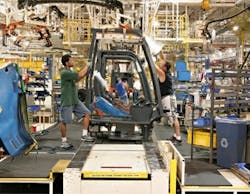Toyota brings kaizen principles to its Indiana plant
If you want to visit a Japanese-style vehicle fabrication and assembly plant, Toyota Industrial Equipment Manufacturing (TIEM) in Columbus, Indiana, is a great choice. The plant builds a broad line of industrial forklifts in a plant that is supported, but not dominated, by computers. They have used teamwork to build a learning workforce of Midwestern Americans. Line workers participate in management meetings daily, adjusting line speed and operations to meet quality, output level, and other needs as they arise.
The TIEM team uses an optimized mix of main chain, guided vehicles, and flexible line layouts to organize vehicle flows. Parts are delivered by trucks from domestic and Japanese manufacturers. A manned storage and retrieval system is used for parts picking to supply kanban systems, most of which are managed by cards and containers. Kanban containers are delivered by guided vehicles and human transport, depending on the part configurations and the needs of the sending and receiving locations.
The overall system is scalable and has accommodated additional models and made significant increases in output since it began production in May 1990. Since first production, the plant has grown to more than a million square feet and the workforce has grown from 56 to about 1,150 people. The product line now includes indoor and outdoor lift trucks with electrical and internal combustion power. Payload capacity ranges from 3,000 to 17,500 lb.
Effectiveness and efficiency
Recommendations
“The Japanese phrase monozukuri wa hitozukuri means ‘Making things is about making people,’” says Lego. “Our improvement initiatives are rooted in the concept that we have to train people to become problem solvers and value them as experts in their work areas. Small daily improvements allow us to continuously experiment with a stable process in order to make it better. We promote this spirit of kaizen or continuous improvement by encouraging these small daily improvements from each associate, through Voluntary Quality Circle teams that tackle larger issues and with cross-functional management directed initiatives that we call ‘jishuken.’ If our people come in with the desire to first be good students, then we will show them the best way that we have been able to do this job, utilizing the standardized work process as a basis for training. After they are fully trained, we encourage them to begin testing one small change at a time to ensure that we continue to find small improvements for safety, quality, productivity, the elimination of waste, and cost reduction.
“We are always looking for opportunities to practice yokoten, the idea of nurturing and sharing our best practices so that they can be applied in similar applications,” continues Lego. “We want to see any problem as an opportunity to make improvement. We do not simply want to be good at taking care of a problem; we want to eliminate its future occurrence. These are truly the treasures of our operation.”
Corporate citizenship
The plant prominently features a “safety dojo” for all of its associates. It is focused upon ongoing safety, with separate areas to focus on all aspects of safety, explains Lego. There is a material handling safety dojo for driver training, skills, and certification. The “How’s Your Process?” section features early symptom intervention with daily confirmation of each associate’s health and safety at the beginning of each shift. “This is an opportunity to meet one-on-one with supervisors before first morning break to discuss any issues or to share ideas,” explains Lego.
The plant was ISO 14001 certified in 1999. According to Lego, all top suppliers have become ISO 14001 or have environmental management systems in place.
“We became a zero landfill facility in 2004,” says Lego. “We have received multiple Indiana governor’s awards for continuous environmental improvement.”
Developments in physical scheduling
“The material handling system was recently improved by introducing new systems for the delivery of set parts — sequenced delivery parts we call junjo — and for lot size delivery parts by internal kanban. These two systems rely upon following standardized delivery routes and methods,” explains Lego.
“The sequential delivery (junjo) process is based upon the progress of the main assembly line,” says Lego. “If the line stops, the kitting of sequenced parts and their delivery to the line stops until the line begins running again. This way, we do not deliver parts too early, being unable to pick up an empty rack, or deliver them too late, and thereby causing line downtime as they wait for the parts.
“For the internally produced kanban parts, we only have small quantities of a wide variety of parts at the line. We need to receive a kanban or signal from the line based upon what they are using. These parts are delivered approximately 2 hours after the card has been mailed to material handling. The pick-up of the cards, the reading and sorting of the cards, distribution to the picking areas, gathering the parts onto delivery carts, and delivery to the line are all based upon 37-minute segments of work. We make 12 deliveries per day and manage the material flow from a central dispatch area called ‘baton touch.’ In this area we coordinate the delivery routes so that we can maintain consistent replenishment of the parts which have been consumed by the main assembly line. These routes run on a consistent 37-minute delivery cycle, and the pitch or frequency of delivery in changed one time per day to equally divide the downtime over the next 12 deliveries,” explains Lego.
“For example, if today we experience 12 minutes of downtime, then tomorrow’s pitch would change from 37 to 38 minutes per delivery process cycle. This way, we can maintain a standard delivery process and adjust the gaps to account for downtime so that we do not deliver too many or too few parts to the line,” explains Lego.


